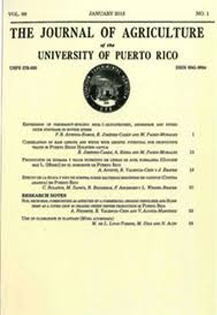Abstract
This study evaluates the effects of feeding growing native lambs complete rations with two percentage levels (D1 and D2) of total digestible nutrients (NDT) on dry matter intake (CVMS), daily (GPD) and total weight gain (GPT), and feed conversion (CA). The effect of diet on carcass yield and yield of main and retail cuts and meat quality was evaluated after slaughter. Productive performance was evaluated using a completely randomized design with two treatments and three repetitions, using the pen as an experimental unit; 18 lambs were used, three per pen. The diets that were evaluated satisfy the nutritional requirements of crude protein (13.3%) with
66% and 73.33% of NDT for D1 and D2, respectively. Diet D1 contained 40% grass hay and 60% commercial concentrate, and D2 a 66:34 ratio of alfalfa and chopped corn. Both diets were offered at 4% of the animal’s live weight on a dry basis (CVPD). During the productive performance test, heat stress was determined using the temperature-humidity index (THI) as a reference and the physiological parameters of the lambs, namely respiratory rate (RR), heart rate (CR) and rectal temperature (TR). After 40 days of feeding, the lambs were slaughtered at an average live weight of 25 kg. To determine J. Agric. Univ. P.R. vol. 105, 2, 2021 225 carcass yield and quality, the individual lamb was used as the experimental unit. During the slaughter process, the weight of the hot carcass and the cold carcass and their respective yields were evaluated. To determine meat
quality, we evaluated pH, color, water retention capacity, tenderness, and nutrient content using the Longissimus dorsi muscle. The experiment was performed under heat stress conditions with THI greater than 72 (average THI of 77.23), and physiological parameters of average CR of 97.01 beats per minute and average RR of 56.64 breaths per minute, values greater than the optimum considered for sheep in their thermal comfort zone. The average TR (39.25) was within the optimal values. The optimal values for these parameters are 39 to 40 °C in TR, 70 to 90 beats per minute and 10 to 20 breaths per minute (Sheep Production Handbook, 2002). The CDPV was higher (P<0.01) in lambs fed D2 (3.77%) than D1 (3.35%). The feed (g/d) consumed, offered, and rejected was similar for both experimental diets. In both diets, the established GPD of 100 g/d was achieved (D1=104.44 g and D2=106.33 g). The weight of the hot (PCC) and cold (PCF) carcass and the performance of the hot (RCC) and cold (RCF) carcass of the lambs were similar between treatments. The PCC and PCF for D1 were 9.47 kg and 9.35 kg, respectively, while D2 showed values of 9.74 kg and 9.47 kg. The RCC were: D1= 37.53% and D2= 38.87%, while the RCF values were: D1=37.03% and D2= 37.67%. The weight of the neck was greater (P<0.01) in animals fed D1 than D2 and the yield of the ‘fricasé’ was greater (P<0.03) in lambs fed D1 (9.35%) than D2 (8.26%). Feedings with different levels of NDT had no effect on meat quality. The pH was higher (P<0.01) in the carcasses of lambs that were fed D2 than in those fed D1. In sum, feeding growing lambs of up to 25 kg average weight with diets that satisfy protein requirements and two percentage levels of NDT greater than the requirement (53%), under conditions of thermal stress, did not affect their productive performance, carcass and meat yield, or meat quality parameters.

